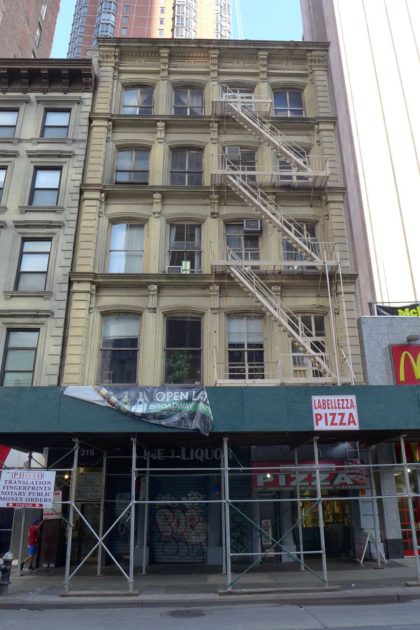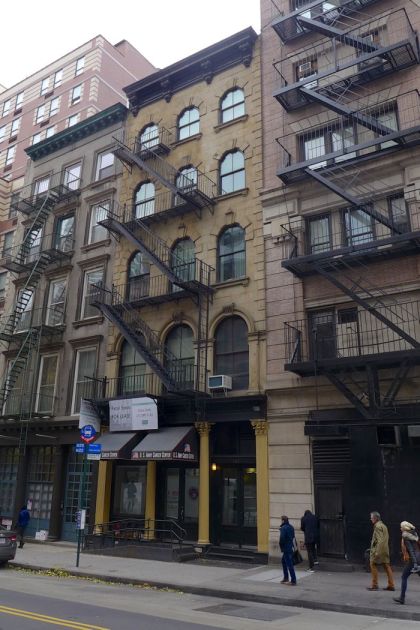Two New Tribeca Landmarks
 The Landmarks Preservation Commission’s backlog of buildings up for landmark status included two in Tribeca: 315 Broadway (above) and 143 Chambers. Last week, the LPC deemed the former a landmark. Here’s its description:
The Landmarks Preservation Commission’s backlog of buildings up for landmark status included two in Tribeca: 315 Broadway (above) and 143 Chambers. Last week, the LPC deemed the former a landmark. Here’s its description:
The 315 Broadway Building is a palazzo-inspired store and loft of the type that once lined Broadway and shaped the streetscapes of pre-civil war New York. These “commercial palaces” were built in the 1850s-1860s throughout the wholesale dry goods district now known as Tribeca. The palazzo style had been popular in the 1830s-1850s among English cotton retailers, to whom it represented the architecture of Renaissance-era merchant princes and provided impressive exteriors for their businesses. The building was constructed as a speculative investment by the retired linen merchant Thomas Suffern in 1861. 315 Broadway has been leased by dozens of tenants since its construction, including the Hagstrom Company, Inc., a cartography and publishing firm that designed and printed the 1943-1956 New York City subway map, from 1948-1969.
 A second Tribeca building was also designated a landmark, but it wasn’t 143 Chambers. It was 160 Chambers (directly above).
A second Tribeca building was also designated a landmark, but it wasn’t 143 Chambers. It was 160 Chambers (directly above).
The Former Firehouse, Engine Company 29 at 160 Chambers Street is one of the city’s earliest surviving police stations, and an early example of the development of Chambers Street and southern Tribeca. It was built in 1832-33 as a three-story residence by Samuel Thomson, a noted builder. In 1836, David B. Ogden, a prominent lawyer, purchased the house and lived here until about 1848. New York City purchased the building in 1862 to serve as the 3rd Police Precinct Station House.
It was raised to five stories and altered in the Second Empire style in 1868 by Nathaniel D. Bush, the official architect of the New York City Police Department. The 3rd Police Precinct Station House was located here until 1875. The building then housed the House of Relief, a hospital under the charge of New York Hospital, from 1875 until 1894. In 1896 the building was further altered at the first story to house the New York City Fire Department’s Engine Company 29, who occupied the building from 1897 to 1947. The City retained ownership until 1962, and from 1947 to 1962 the Uniformed Fire Officers Association occupied the building. It was converted to commercial use in 1967, and since the mid-1980s the building has had commercial use at the ground story with residential units above. The building remains mostly intact since its 1868 and 1896 alterations.
The extensive “designation reports” for each building don’t appear to be on the LPC site yet, but anyone who’d like to see the PDFs should feel free to email me at tribecacitizen@gmail.com.
As for 143 Chambers (below), it was removed from the calendar for consideration in February, but it could theoretically be added back at a future date.

















Fun fact regarding landmarked firehouses. Many of the ones that remain as active firehouses (unlike 160 Broadway above) were designed to handle horse carriages, not trucks. You can see in the picture that it isn’t a very wide entrance. Modern firetrucks are wider than the doors of these buildings, so FDNY is forced to custom-build their fleet of trucks to fit the remaining landmarked buildings. It costs a ton, but frankly, I think those buildings are worth saving.
i am glad 315 b-way got landmarked. i am a former tenant there and i must say it is a cool old building. i hope the artists who work there are able to stay under the new owners.
Good history of 160 Chambers St:
http://daytoninmanhattan.blogspot.com/2012/08/engine-company-no-29-160-chambers-street.html
Astounding to me that you don’t mention the work that Tribeca Trust did to get these buildings protected.
Lynn
I wasn’t aware of it, but that’s great Tribeca Trust had an impact.